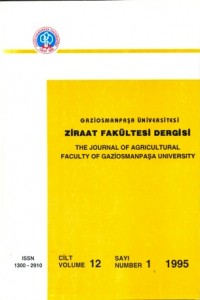The Effects of Inoculation (Rhizobium ssp.), Nitrogen Application and Plant Density on The Yield and Yield Components of Chickpea (Cicer arietinum L.)
Abstract
This research was conducted at the University of Cumhuriyet, Agricultural Faculty of Tokat, in Department of Agronomy during 1987 and 1988. The aim of this research was to determine the effects of inoculation (Rhizobium ssp.), plant density and doses of nitrogen on the yield and yield components of chickpea (Cicer arietinum L.) . With this aim, the seeds of regional chickpea cultivar were used as material . The seeds were treated Rhizobium inoculant and then sown in three plant densities between rows (20, 30 ve 40 cm) and four nitrogen doses (0.0, 2.5, 5.0 and 7.5 kg N/da) were given. The results of this research which were made as four replicates and split-split plots trial design are given below. Inoculation with Rhizobium ssp. have caused significantly and positively differences on the characters of number of pods and seeds per plant, seed and biological yield per plant and seed yield per decare in both years. The biological yield per plant in both years , number of pods and seed per plant and seed yield per decare in 1987 were significantly and positively affected by nitrogen doses. The spaces between rows have caused significantly differences which were positive direction on the characters of number of pods and seeds per plant, seed and biological yield per plant and seed yield per decare in two years. Different treatments have not caused any differences on the characters of harvest index per plant. It was determined that, with regard to seed yield per decare, the optimum combination in bacteria inoculated conditions was 20 cm row distance (100 plant/m2 ) and 2.5 kg N/da in chickpea, while without bacteria inoculation, this combination needed to be 20 cm row distance ( 100 plant/m2 ) and 7.5 kg N/da.
Bakteri (Rhizobium ssp.) Aşılama, Azot Dozları ve Ekim Sıklığının Nohut (Cicer arietinum L.) ‘ un Verim ve Verim Unsurlarına Etkileri
Abstract
Bu araştırma 1987 ve 1988 yıllarında Cumhuriyet Üniversitesi , Tokat Ziraat Fakültesi , Tarla Bitkileri Bölümünde yapılmıştır. Çalışmada ; bakteri aşılama , dört azot (0.0, 2.5, 5.0 ve 7.5 kg N/da) ve üç sıra arası açıklığının (20, 30 ve 40 cm) Yerli nohut çeşidinde verim ve verim unsurlarına etkileri araştırılmıştır. Bölünen-bölünmüş parseller deneme deseninde dört tekrarlamalı olarak yapılan denemeden sağlanan sonuçlar özetlenmiştir. Bakteri aşılaması bitkide bakla ve tane sayılarını, bitkide tane ve biyolojik verimi ve dekara tane verimini 1987 yılında önemli düzeyde olumlu etkilemiştir. Azot dozları bitkide biyolojik verimi her iki yılda, bitkide bakla ve tane sayıları ile bitkide ve dekarda tane verimini her iki yılda da önemli ve olumlu etkilemiştir. Sıra arası açıklığının artışı bitkide bakla ve tane sayısmı , bitkide tane ve biyolojik verimi ve dekara tane verimini her iki yılda da önemli ve olumlu etkilemiştir. Değişik uygulamalar bitkide hasat indeksini önemli etkilememiştir. Nohutta (dekara tane verimi yönünden ), bakteri aşılanmış koşullarda 20 cm sıra aralığı (100 bitki/m2 ) ve 2.5 kg N/da uygulaması; bakterisiz koşullarda da 20 cm sıra aralığı (100 bitki/ m2 ) ve 7.5 kg N/da uygulamasının en uygun kombinasyonlar olduğu belirlenmiştir.
Details
| Primary Language | Turkish |
|---|---|
| Journal Section | Research Articles |
| Authors | |
| Publication Date | June 1, 1995 |
| Published in Issue | Year 1995 Volume: 1995 Issue: 1 |

